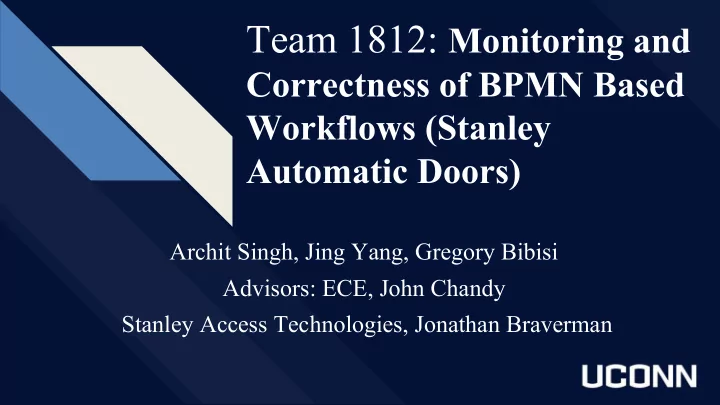

Team 1812: Monitoring and Correctness of BPMN Based Workflows (Stanley Automatic Doors) Archit Singh, Jing Yang, Gregory Bibisi Advisors: ECE, John Chandy Stanley Access Technologies, Jonathan Braverman
Project Overview Stanley Access Technologies (Farmington, CT) • Dura Glide Slide Door System: Number one in sales • Aluminum panels that are driven with a motor and a belt system Stanley needs a system to diagnose problems in the automatic doors • Design a system that interfaces with the Door Control Unit (DCU) • System detects anomalies and reports via bluetooth to an Android App to technician with recommendations • Joint project with CSE
Our Job (Simple Overview) • Detect and communicate currents and voltages for all possible components (currently both sensors, motor) – For the troubleshooting app to be effective, it needs all relevant information • Voltages and currents from components • Error codes from DCU and Terminal Block connector errors – Both of these already in current system – Communicate this data through bluetooth • DCU already has communication through bluetooth set-up – Direct communication • Currently working on Dura Glide Slide Door System – Project needs to be scalable, or easily upgraded, so it can be implemented on different types of doors when needed
Setup Dura-Glide Automatic Slide Door System 1. Motor 1 2. MC521 PRO Control Box (DCU) 3. SU-100 Motion Sensor 4. Solenoid Lock
Motor 1 • Requires a voltage supply of 120VDC – From DCU • Armature resistance of 12 Ohms • Connected to a relative encoder • Controlled by DCU, DCU controlled by rotary switch/encoder
Sensors SU-100 Motion Sensor • Unidirectional or bidirectional sensing – Senses motion at a threshold of 2 inches/s Stanguard Threshold Sensor • Powered by DCU (14V) 1A max • Reflective infrared sensor
Fall Semester Timeline
Motor Test- Total Input Voltage ● Measured door voltage is 117V RMS. Rated voltage is 120V RMS ● Motor supply voltage is 91V RMS DC voltage supply to Motor DC power supply to the door system
Motor Test- Motor Voltage ● 85V RMS which it is below the motor rated voltage 120VDC ● Different direction ● Armature resistance 12 ohm Motor voltage when door open Motor voltage when door close
Brief Design Structure
Design Solution Microcontroller: • Need a microcontroller that can connect with the DCU, sensors and bluetooth. • Needs to transmit all of the information (a lot of information from DCU, relatively little information from sensors) to the bluetooth. • Need microcontroller with adequate ports for the bluetooth connector.
Current/ Voltage Sensors ● Sensors to monitor motor, lock, and the sensors ● Needs to communicate with our choice of microcontroller ● Need to be able to handle the maximum readings values we can get get from each source (especially when it malfunctions) ● Needs to read information without disrupting ACS714 Current Sensor
Budget Stanley provided spare equipment and components ACS714 Current Sensor (x4) $8.95 ATmega328p with ethernet mod $44.13 ATmega328p XMINI $9.13 Total Budget $79.93
Short Term Goals ● Testing the current and voltage limit of every component including sensors and motors ● Current/voltage sensors selection ● Microcontroller selection ● Wire connection between the current/voltage sensors and DCU component ● Make sure the communication between DCU and microcontroller has minimum error
Long Term/ End Goals Measure and communicate all relevant information • Measure – Voltages and currents from solenoid lock, motor, sensors – Picking the correct sensors and implementing them • Correct ranges for input/output • Analog or digital output • Communicating – Through DCU • Use already established DCU-Bluetooth-Android communications • DCU has spare I/O, but lacks analog digital convertor (unclear if needed) • ATmega328p – Has adequate ADC – Direct Communication • Set up direct communication from sensors to app – Not preferred, requires new communication connections, as well as more bluetooth adapters
Recommend
More recommend